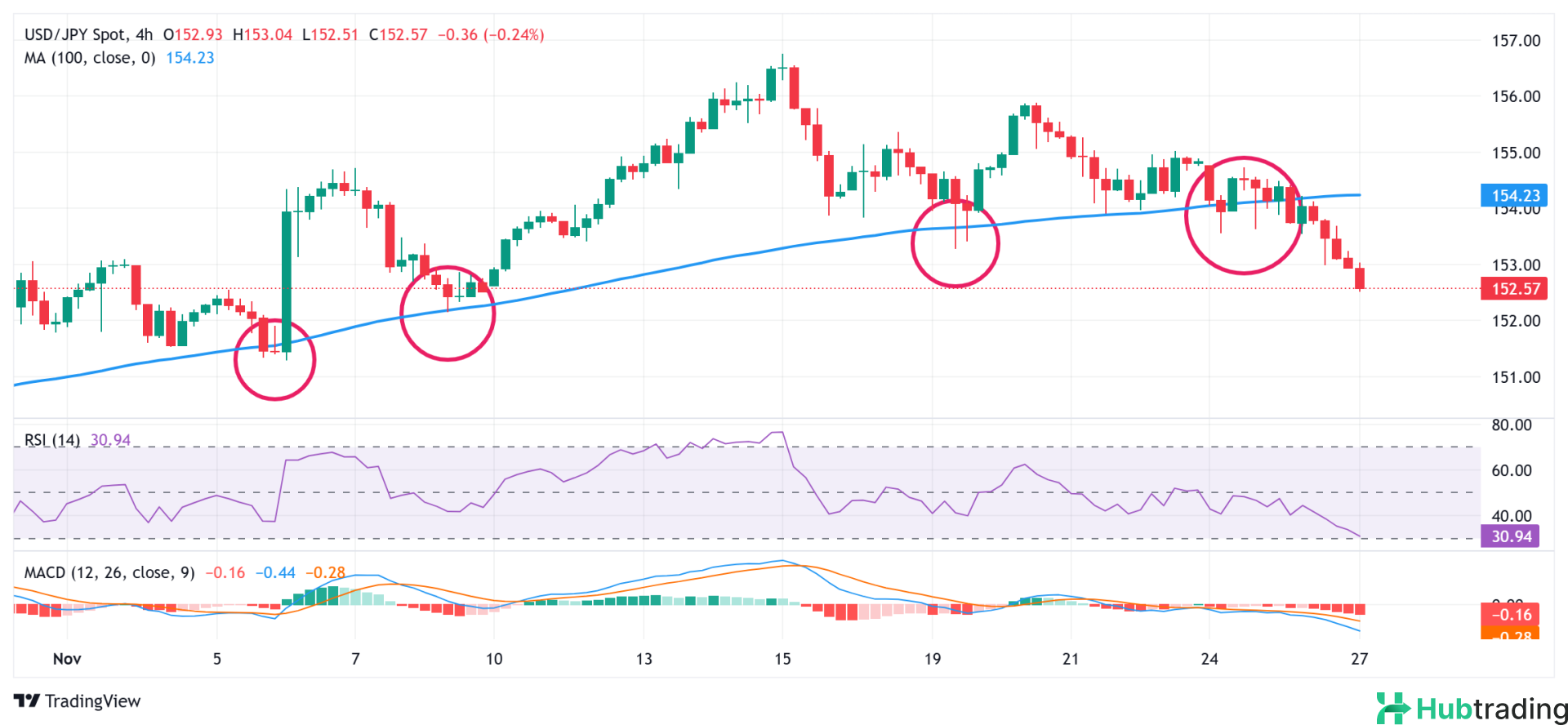- The Japanese Yen benefits from safe-haven flows driven by concerns over Trump's tariff plans and escalating geopolitical risks.
- The USD remains near its weekly low, pressured by declining US bond yields, which drags the USD/JPY pair lower.
- Uncertainty surrounding a potential BoJ rate hike urges caution for JPY bulls ahead of key US inflation data.
The Japanese Yen (JPY) maintains its upward momentum on Wednesday, supported by modest US Dollar (USD) weakness, pulling the USD/JPY pair below the 152.00 level to hit a three-week low during the early European session. Safe-haven demand for the JPY is fueled by persistent geopolitical tensions arising from the prolonged Russia-Ukraine conflict and concerns over US President-elect Donald Trump's proposed tariff measures.
Adding to the pressure on the USD, expectations that Treasury Secretary nominee Scott Bessent will focus on reducing budget deficits have driven US Treasury bond yields lower. This keeps USD bulls on the back foot near weekly lows, further bolstering the lower-yielding JPY. However, uncertainty surrounding the Bank of Japan's (BoJ) stance on potential rate hikes may limit JPY gains ahead of key US macroeconomic data releases later on Wednesday.
Japanese Yen Bulls Maintain Control Amid Safe-Haven Demand and Declining US Bond Yields
- Concerns over US President-elect Donald Trump's proposed tariffs, which could spark trade wars and impact the global economy, continue to drive safe-haven flows toward the Japanese Yen (JPY).
- Adding to the Yen’s appeal, Scott Bessent's nomination as US Treasury Secretary has reassured bond investors, pushing the 10-year US Treasury yield to a two-week low on Monday.
- Domestic factors also support the JPY, with Tuesday’s data revealing rising service-sector inflation in Japan, keeping the possibility of another Bank of Japan (BoJ) rate hike in December alive.
- Japanese Prime Minister Shigeru Ishiba announced plans to advocate for significant wage increases during the annual "Shuntō" negotiations next spring, further bolstering sentiment for the Yen.
- Minutes from the Federal Reserve’s November FOMC meeting highlighted the possibility of pausing rate cuts if inflation remains elevated.
- While officials expressed confidence in easing inflation and a strong labor market, the Fed is expected to continue rate cuts at a measured pace. The CME Group's FedWatch Tool indicates a 63% probability of a 25-basis-point rate cut in December, adding to the US Dollar's struggles near its weekly low and pressuring the USD/JPY pair.
- Tensions in the Middle East persist, with Hezbollah launching drones toward Israel on Tuesday night and Israel responding with airstrikes on Beirut's southern suburbs. Shortly after, US President Joe Biden announced a ceasefire agreement between Lebanon and Israel, effective from 02:00 GMT Wednesday.
- Market participants now await the first revision of the US Q3 GDP report and the US Personal Consumption Expenditure (PCE) Price Index for fresh impetus.
- Later this week, attention will shift to key Japanese macroeconomic releases, including Tokyo's Core CPI data, scheduled for Friday’s Asian session.
USD/JPY Break Below 152.00 Support Signals Potential for Deeper Losses

From a technical standpoint, the overnight close below the 100-period Simple Moving Average (SMA) on the 4-hour chart, followed by continued weakness, reinforces a bearish outlook for USD/JPY. Daily chart oscillators have begun to gain negative momentum, supporting the likelihood of further declines. This suggests a move toward the critical 200-day SMA, currently around the 152.00 mark, is increasingly likely. A decisive break below this level could pave the way for a drop to the monthly swing low in the 151.30-151.25 region.
On the upside, the 153.00 level now serves as immediate resistance, followed by the 153.25-153.30 zone. Sustained strength beyond this range could spark a short-covering rally, pushing the USD/JPY pair back toward the 154.00 mark. Further gains may target the 154.60 intermediate resistance, with the next key hurdles at the 155.00 psychological level and the 155.35-155.40 area.





